Astrobee 350
By Joseph Olexa
2011-04-17
4/16/2011 Started to build the Semroc Astrobee 350. I had bought the kit on Ebay from a hobby shop. The kit looked pretty nice for a four fin balsa nosecone rocket. the specs are as follows: Body diameter 1.040 inches, Length 16.2 inches, fin span 3.5 inches (More on this), weight 1 ounce, and uses a 12 inch plastic parachute. I went to the Semroc website and noticed that the rocket was no longer listed. I emailed the company and was told that they had taken the rocket off the website but was using a new larger fin for it. They sent me the new larger fins for the rocket and that is the second set of fins in the parts photo. Today I started assembling the motor mount following the instructions and using the metal motor clip top end to secure the kevlar shock cord. 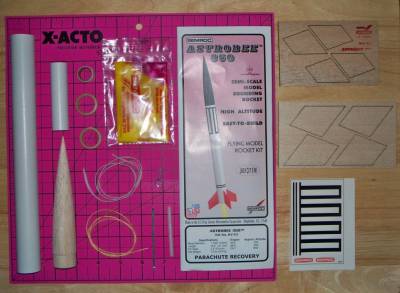 When assembling the motor mount I applied some 15 minute epoxy under the motor clip between the two motor centering rings. I feel this takes some of the impact when the ejection charge goes off and the motor casing presses on the exposed lower end of the motor mount clip. I also applied some white glue to the kevlar knot and also on the cut end of the kevlar string to keep it from fraying when subjected to the ejection charge. I'm giving the epoxy the night to harden, even though it's 15 minute epoxy. Tomorrow I'll put in the white glue fillets on the centering rings. The motor mount will then be finished and I'll move on to the next step.
When assembling the motor mount I applied some 15 minute epoxy under the motor clip between the two motor centering rings. I feel this takes some of the impact when the ejection charge goes off and the motor casing presses on the exposed lower end of the motor mount clip. I also applied some white glue to the kevlar knot and also on the cut end of the kevlar string to keep it from fraying when subjected to the ejection charge. I'm giving the epoxy the night to harden, even though it's 15 minute epoxy. Tomorrow I'll put in the white glue fillets on the centering rings. The motor mount will then be finished and I'll move on to the next step.
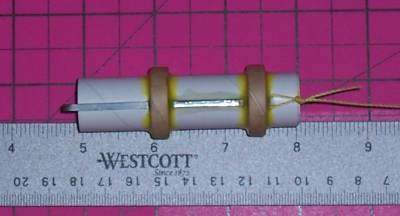 4/17/2010 Put glue fillets on the centering rings of the motor mount. I used yellow wood or carpenters glue. I'm letting them dry overnight before proceeding with the assembly. So far it looks nice,
4/17/2010 Put glue fillets on the centering rings of the motor mount. I used yellow wood or carpenters glue. I'm letting them dry overnight before proceeding with the assembly. So far it looks nice,
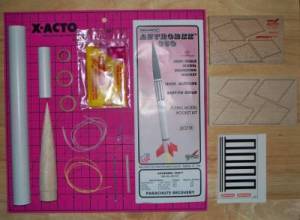
Preparing The Fins
2011-04-20
4/18/2011 Today I cut the fins out of the balsa sheet. Wasn't much to do since the fins are laser cut. I traced the outline of the fins and also traced the open "holes" in the balsa sheet in order to make a PDF file of the fin design. I plan to attach it to the build so anyone else can cut new fins for the Astrobee 350. I still have to have the paper scanned, and I hope I can attach a PDF file. I think the outline traces of the fins may be a better choice for cutting, but both traces are there for your choice. I sanded the balsa fins so they would all be the same size - not much to sand either since they were pretty accurately cut.
Glued fins onto rocket body tube
2011-04-20
4/19/2011 Today I glued the fins and lunch lug onto the rocket body tube. I left the rocket motor mount out so I can better estimate the correct placement of the fins as I glued them into position. I used yellow carpenters glue for this. Then I glued the launch lug onto the body using superglue gel. After gluing the fins and launch lug on, I'm leaving the glue dry until tomorrow where I will begin to add the fillets for the fins and launch lug. 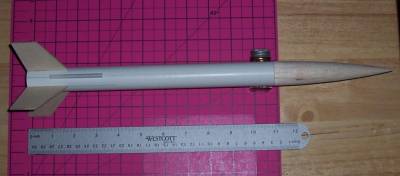
4/20/2011 Began to put fillets on the rocket fins. Will continue onto other fins/areas once the glue has dried in the area I worked on tonight. The glue took longer than I anticipated to dry. I'm using some thin superglue so it can run into any areas the yellow glue hasn't spread to when gluing them on the previous night. Once I use one coat of superglue on each fin joint, I will finish off the fillets with yellow glue. It seems to me the paint will adhere to the yellow glue better than the super glue when I finally get to painting the rocket.
4/21/2011 Finished putting the superglue fillets on the fins, next step is to finish the fillets off with yellow carpenters glue, after that it's off to seal the balsa fins and nosecone prior painting the rocket. I seal the balsa wood with a mixture of white glue (I use Elmers) and micro balloons mixed into the white glue. I still have to glue the engine mount into the body tube - but that shouldn't take long.

Sealing the Balsa Fins and Nosecone
2011-05-04
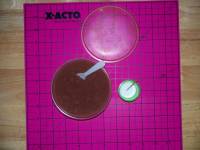 I started to seal the balsa fins with a mixture of micro-balloons(it looks like powder) and diluted white glue (water thinned elmers glue). I had put about two yellow (carpenters) glue fillets over the superglue in the last step, and now I am sealing the balsa. First I painted the balsa with two coats of plain white glue thinned with water to the consistancy of paint. I sanded that down so it was smooth after it was dried. The glue also soaked into the balsa, making it slightly tougher. After that I mixed some brown micro-balloons into a mixture of diluted white glue. When you've added enough micro-balloons into the mixture make sure it has the consistancy of paint, if too thick, add a few drops of water. I mixed my glue in a plastic shot glass I bought at Walmart. You can buy the microballoons at Discount Rocketry, I also think you can buy it at Hobbylinc, but the powder is white instead of brown, but it should do the same thing. I've also seen it at my local hobby shop. after the micro-ballon glue mixture has dried on the balsa, sand it down with an emry stick/board. The stick is flatter and more stiff than sand paper and will tend to sand the glue more smoothly on the flat fins. Just make sure you don't sand too much and sand into the balsa. The round nosecone was simply sanded with sandpaper. In my case with the Astrobee, it only needed one coat of the Micro-balloon mixture to seal the balsa smooth, sometimes it takes more coats if the balsa is more porus. I have an Estes Vector Force rocket I'm also working on and it'll take more than one coat to seal all the pores in the wood. In the photo I pasted in, it shows the tub of micro-balloons and the plastic shot glass with diluted white glue with a toothpick for mixing the mixture. I got the small plastic spoon from one of the Chicken of the Sea Tuna lunch snacks - it comes with a small can of tuna and some crackers. The spoon was just the right size for spooning out the microballoons from the plastic tub. after pretty much sanding the glue down smooth, and there are no more pores to seal, then I sand it with a fine grain sandpaper to make it even smoother.
I started to seal the balsa fins with a mixture of micro-balloons(it looks like powder) and diluted white glue (water thinned elmers glue). I had put about two yellow (carpenters) glue fillets over the superglue in the last step, and now I am sealing the balsa. First I painted the balsa with two coats of plain white glue thinned with water to the consistancy of paint. I sanded that down so it was smooth after it was dried. The glue also soaked into the balsa, making it slightly tougher. After that I mixed some brown micro-balloons into a mixture of diluted white glue. When you've added enough micro-balloons into the mixture make sure it has the consistancy of paint, if too thick, add a few drops of water. I mixed my glue in a plastic shot glass I bought at Walmart. You can buy the microballoons at Discount Rocketry, I also think you can buy it at Hobbylinc, but the powder is white instead of brown, but it should do the same thing. I've also seen it at my local hobby shop. after the micro-ballon glue mixture has dried on the balsa, sand it down with an emry stick/board. The stick is flatter and more stiff than sand paper and will tend to sand the glue more smoothly on the flat fins. Just make sure you don't sand too much and sand into the balsa. The round nosecone was simply sanded with sandpaper. In my case with the Astrobee, it only needed one coat of the Micro-balloon mixture to seal the balsa smooth, sometimes it takes more coats if the balsa is more porus. I have an Estes Vector Force rocket I'm also working on and it'll take more than one coat to seal all the pores in the wood. In the photo I pasted in, it shows the tub of micro-balloons and the plastic shot glass with diluted white glue with a toothpick for mixing the mixture. I got the small plastic spoon from one of the Chicken of the Sea Tuna lunch snacks - it comes with a small can of tuna and some crackers. The spoon was just the right size for spooning out the microballoons from the plastic tub. after pretty much sanding the glue down smooth, and there are no more pores to seal, then I sand it with a fine grain sandpaper to make it even smoother. 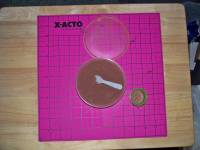 In the second photo it shows the shotglass with the micro-balloon mixture in it. They tend to sort of float in the glue, so as you use up the glue, there are less and less microballoons left in the glue. There are other ways to seal balsa fins. Some people glue paper to the sides of the balsa so it is completely smooth, and I've done that on two of my rockets, I used white glue to glue the paper to the balsa (you may have to put something heavy on it so it dries smooth with no wrinkles), then gave it a coat of super glue. The glue seeps into the paper. and hardens. Some people may use diluted elmers wood filler instead to seal and fill up the pores in the balsa. I haven't personally tried that one yet, but it works for some people. For some reason I keep coming back to painting the fins with white glue. It's worked well for me. One more thing. If you have a dent or cut in the balsa that needs to be filled in, first sand it smooth so no piece of balsa is sticking up, them paint the balsa with white glue. After the glue dries, then apply the putty to the dent and sand the putty when it's dry. The glue you painted onto the balsa makes it harder and when you sand the putty down, it doesn't also sand the balsa too much and create a flat spot. If you don't do this, the balsa is so soft you may make a flat spot, however you may get away with it if you use the wood filler but I can't verify that. The putty I use is Squadron Green putty that I also use on my plastic models, so it may be harder than the wood filler. The Astrobee 350 has two small dents in the balsa nosecone from shipping that I used putty to fill up and sand smooth. It came out nice. In my next photo I show the Astrobee 350 with the fins coated with the Glue mixture, that's why the fins are brown. The next step is to sand the glue mixture down until it's smooth. I plan on adding one or two more coats of yellow glue for the fin fillets and then it will be ready for the primer paint.
In the second photo it shows the shotglass with the micro-balloon mixture in it. They tend to sort of float in the glue, so as you use up the glue, there are less and less microballoons left in the glue. There are other ways to seal balsa fins. Some people glue paper to the sides of the balsa so it is completely smooth, and I've done that on two of my rockets, I used white glue to glue the paper to the balsa (you may have to put something heavy on it so it dries smooth with no wrinkles), then gave it a coat of super glue. The glue seeps into the paper. and hardens. Some people may use diluted elmers wood filler instead to seal and fill up the pores in the balsa. I haven't personally tried that one yet, but it works for some people. For some reason I keep coming back to painting the fins with white glue. It's worked well for me. One more thing. If you have a dent or cut in the balsa that needs to be filled in, first sand it smooth so no piece of balsa is sticking up, them paint the balsa with white glue. After the glue dries, then apply the putty to the dent and sand the putty when it's dry. The glue you painted onto the balsa makes it harder and when you sand the putty down, it doesn't also sand the balsa too much and create a flat spot. If you don't do this, the balsa is so soft you may make a flat spot, however you may get away with it if you use the wood filler but I can't verify that. The putty I use is Squadron Green putty that I also use on my plastic models, so it may be harder than the wood filler. The Astrobee 350 has two small dents in the balsa nosecone from shipping that I used putty to fill up and sand smooth. It came out nice. In my next photo I show the Astrobee 350 with the fins coated with the Glue mixture, that's why the fins are brown. The next step is to sand the glue mixture down until it's smooth. I plan on adding one or two more coats of yellow glue for the fin fillets and then it will be ready for the primer paint. 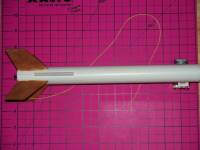 I also have glued in the motor mount so the fins will not flex too much when sanding them. The string you see there is the kevlar shock cord that is attached to the motor mount. I'll pull it back through the top once I get ready to paint the rocket body. I had to pull it through the motor mount when I glued it into the rocket body so it wouldn't get caught in the glue. The next step is to sand it smooth and prime the rocket and get it ready for it's final coat. I want to add one note - there are reports that you can use talcum powder mixed into the glue to get the same result as micro-balloons. I have never tried this approach so I can't say if it works or not.
I also have glued in the motor mount so the fins will not flex too much when sanding them. The string you see there is the kevlar shock cord that is attached to the motor mount. I'll pull it back through the top once I get ready to paint the rocket body. I had to pull it through the motor mount when I glued it into the rocket body so it wouldn't get caught in the glue. The next step is to sand it smooth and prime the rocket and get it ready for it's final coat. I want to add one note - there are reports that you can use talcum powder mixed into the glue to get the same result as micro-balloons. I have never tried this approach so I can't say if it works or not.

Painting the Astrobee 350
2011-06-04
 Finally got time to finish painting the Astrobee 350. I've been using Krylon paint on this one. The whole rocket was sprayed with white primer and sanded lightly. Next, I painted the whole rocket, except for the nosecone, white. The nosecone was painted black and left to dry. For the rest of the rocket, I left it dry for a few days before masking the fin areas so I could paint them red. This went ok, but I did have to touch up a few small spots where the red paint got under the masking tape. I'm not using regular masking tape, I'm using Pactra model masking tape which does a better job of keeping the paint from getting underneath. It was just a little more difficult to mask around the launch lug and that's where the paint seeped under the tape. looks good. I've put a photo of what it looks like now. The next step is to decal the rocket.
Finally got time to finish painting the Astrobee 350. I've been using Krylon paint on this one. The whole rocket was sprayed with white primer and sanded lightly. Next, I painted the whole rocket, except for the nosecone, white. The nosecone was painted black and left to dry. For the rest of the rocket, I left it dry for a few days before masking the fin areas so I could paint them red. This went ok, but I did have to touch up a few small spots where the red paint got under the masking tape. I'm not using regular masking tape, I'm using Pactra model masking tape which does a better job of keeping the paint from getting underneath. It was just a little more difficult to mask around the launch lug and that's where the paint seeped under the tape. looks good. I've put a photo of what it looks like now. The next step is to decal the rocket.

Decaling the Astrobee 350
2011-06-04
 This is the Astrobee 350 after it's been decaled. I waited about a week before I started to put the decals on. As always the large decal under the nosecone was the hardest to put on. After you soak the decal in water to loosen it off the paper, make sure it's loose enough to come off easily. If you try to slide it off the paper before it's loose enough, you will stretch the decal and ruin it. This is especially important when putting the large decal below the nosecone on. The next challenge was the double stripe decal above the fin. Unfortunately it would go over the launch lug. I measured the decal while it was still dry on the paper and cut it short so it doesn't go over the lug. I think it still lools good where it stops before and picks up after the launch lug. Now that the decals are on, I'll wait at least 24 hours before even thinking about gloss coating the rocket. When my schedule allows, probably a few days from now, I'll spray paint it with gloss clear paint. This will seal the decals so they won't come up, and give the rocket a very glossy finish over its entire length. After the gloss coat is dry, I'll start to attach the shock cord and add the parachute. It'll be finished then.
This is the Astrobee 350 after it's been decaled. I waited about a week before I started to put the decals on. As always the large decal under the nosecone was the hardest to put on. After you soak the decal in water to loosen it off the paper, make sure it's loose enough to come off easily. If you try to slide it off the paper before it's loose enough, you will stretch the decal and ruin it. This is especially important when putting the large decal below the nosecone on. The next challenge was the double stripe decal above the fin. Unfortunately it would go over the launch lug. I measured the decal while it was still dry on the paper and cut it short so it doesn't go over the lug. I think it still lools good where it stops before and picks up after the launch lug. Now that the decals are on, I'll wait at least 24 hours before even thinking about gloss coating the rocket. When my schedule allows, probably a few days from now, I'll spray paint it with gloss clear paint. This will seal the decals so they won't come up, and give the rocket a very glossy finish over its entire length. After the gloss coat is dry, I'll start to attach the shock cord and add the parachute. It'll be finished then.

Finished Gloss Coating the Astrobee 350
2011-06-12
I finished gloss coating the Astrobee 350. I had intended to gloss coat the whole rocket - including the nosecone, but after looking at the nosecone I thought it was glossy enough. The main body tube and fins received two coats of clear Krylon paint. This gave the whole rocket an even gloss finish and also has the effect of sealing the water slide decals so there is less a chance of them coming off. I took two photos of the rocket, the front side and the back side showing the launch lug. All that's left is adding the parachute and shock cord.
Sponsored Ads
 |
 |












